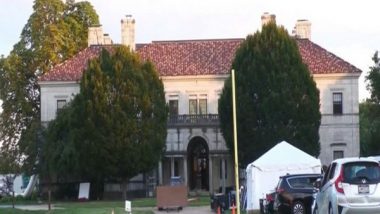Project 2025 , a contentious policy blueprint for the next Republican presidency, seeks to dramatically concentrate power in the White House while fundamentally changing how the federal government operates on nearly every front. And when it comes to overhauling public education, the sweeping right-wing manifesto borrows heavily from Arizona’s playbook. The roughly 900-page “Mandate for Leadership”—crafted by think tank the Heritage Foundation and other conservative heavyweights—lays out an aggressive roadmap for dismantling the federal Department of Education, rethinking funding for low-income students and those with disabilities, and broadly diverting public school dollars to less-regulated alternatives like private schools and homeschooling.
Promoting universal school choice as “a goal all conservatives and conservative Presidents must pursue,” it argues that “every parent should have the option to direct his or her child’s share of education funding through an education savings account (ESA), funded overwhelmingly by state and local taxpayers.” That’s precisely how school vouchers work in Arizona, a longtime darling of the school choice movement and the first in the nation to offer universal voucher eligibility. Heritage education policy expert Lindsey Burke, who authored Project 2025’s education section, references Arizona as a school choice pioneer almost immediately.

Burke also advocates a change to the Individuals with Disabilities Education Act that would partially redirect IDEA funding to families instead of schools, citing “the way in which parents use education savings accounts in states such as Arizona and Florida.” And she promotes a funding model in which donors receive tax credits in exchange for contributions to nonprofits that provide private school scholarships, much like Arizona’s school tuition organizations , or STOs. Burke and others from the Heritage Foundation, which declined an interview with AZCIR , use conservative buzzwords like “freedom” and “choice” to sell their vision of a new educational landscape that empowers parents to select a “set of education options that meet their child’s unique needs.
” But experts in education policy and constitutional law suspect a much different endgame: setting public schools up to fail by stripping their funding while concentrating higher-need, harder-to-educate kids there. “The implications for students and public schools and the communities that rely on them are disastrous,” said Jessica Levin, litigation director at the Education Law Center, a nonprofit that advocates for public education. “And Arizona, unfortunately, is Exhibit A.
” Arizona’s initial foray into school choice came in 1994, when the state passed a far-reaching education-reform package that authorized charter schools to operate here. Three years later, the state became the first in the U.S.
to establish nonprofit school tuition organizations to fund private school scholarships, offering dollar-for-dollar tax credits to donors. By 2006, the Legislature had created an explicit school voucher option limited to students with disabilities and those in foster care. The Arizona Supreme Court later deemed that program unconstitutional, because it directly funded private, often religious schools.
Policymakers soon changed course, launching the nation’s first “ Empowerment Scholarship Account ” program in 2011. ESAs, initially available to students with disabilities, similarly diverted state money to public school alternatives, but they circumvented the court’s decision by giving the cash to parents to spend. Republican leaders first expanded program eligibility incrementally, then dramatically.
Today, Arizona has the largest share of charter school students in the country. Its STOs rake in hundreds of millions annually, funneling would-be tax revenue to private schools. And its now-universal voucher program enrolls nearly 75,000 students , to the tune of more than $700 million.
The state also has some of the worst-funded public schools in the U.S., ranking 49th on the U.
S. Census Bureau’s most recent Annual Survey of School System Finances. Even before the state universalized voucher eligibility, Columbia University researchers who analyzed education budgets from 2008 to 2019 found Arizona was one of the few states where public school spending declined even as enrollment increased.
Per-pupil public school spending dropped by 5.7% during that period, according to the analysis, while spending on voucher and tax-credit programs climbed by 270%. “(Arizona) has consistently refused to create quality public schools, and therefore forced people—and I think that’s the key, forced people—to make other choices,” said University of South Carolina Professor Derek Black, who specializes in the intersection of constitutional law and public education.
In other words, the harder you make it for public schools to succeed, the easier it is to sell the alternatives. And there are plenty of well-financed conservative groups working to do just that. Former U.
S. Education Secretary Betsy DeVos’ American Federation for Children, the Koch brothers’ Americans for Prosperity and the American Legislative Exchange Council have all doggedly pushed for expansions in vouchers and other school choice programs throughout the country in recent years, using Arizona as a proving ground. Libertarian think tank the Goldwater Institute, the primary architect of Arizona’s ESA program, has repeatedly said it “won’t stop until parents in every state in the nation are empowered to decide what educational path truly meets their children’s needs,” though it declined to discuss the implications of Project 2025’s voucher proposal with AZCIR.
Framing education as a consumer product rather than a public good, these groups argue families should have the ability to escape subpar, out-of-touch public schools in favor of private or self-directed options that better serve their kids and more closely reflect their values—all on the taxpayer’s dime. That argument has gained traction amid some families’ frustrations over how public schools navigated the COVID-19 pandemic, as well as ongoing culture wars over issues of race, gender and sexuality. (Heritage Foundation President Kevin Roberts writes in Project 2025’s forward that the “noxious tenets of ‘critical race theory’ and ‘gender ideology’ .
.. poison our children.
”) But in most cases, it’s Republican lawmakers , not families, who have pushed hardest to make it easier for public dollars to go toward private alternatives. Every time major voucher expansions have been put to the public, including in Arizona, voters have rejected them. Project 2025 paints a rosy picture of an educational marketplace where parents hold the ultimate power to customize their child’s learning experience.
As Roberts puts it in his introduction, “Schools serve parents, not the other way around.” Indeed, parents of some public school students—from those with disabilities who needed special instruction, to those from lower-income families who felt trapped at failing or unsafe schools—have successfully used vouchers to find and afford placements better tailored to their children’s learning styles. “A family may have three children, two of whom thrive at their neighborhood public school, but one struggles, and the parents choose to get ESA funds to send that child to a school that meets his needs,” Arizona Superintendent of Public Instruction Tom Horne said.
“I believe school choice options should be available to parents throughout the country as decided on a state-by-state basis.” At the end of the day, though, only public schools must be open to all. Private schools can generally pick which students to accept or reject, meaning they ultimately do the choosing, not families.
In Arizona, that has left some parents who’ve pursued vouchers for children with disabilities unable to find spots for them. Those who do secure private school placements give up certain anti-discrimination and disability protections present at public schools. These considerations apply to the minority of Arizona ESA recipients who’ve left district or charter schools in favor of private schools since the state universalized eligibility.
Over the past two school years, more than 60% of ESAs went to students who weren’t previously enrolled in public school, state data shows, indicating families are likely using vouchers to subsidize expenses they had formerly covered. Rather than saving the state money, as school choice advocates claimed ESAs would, both of these shifts have created budgetary strain. School districts, which rely on consistent enrollment for state funding, have seen cash disappear alongside students, even as fixed costs have remained steady.
The state, meanwhile, has taken on hundreds of millions in new spending for kids who were already attending private school, a trend that contributed to a $1 billion-plus budget deficit this year. Under Arizona’s existing laws, it’s almost impossible to see how students who use vouchers for private schools or homeschooling are performing, since they generate very little data . They don’t have to participate in state or national assessments, for instance, and their grades, graduation rates and postsecondary attainment go unreported.
Levin cited a lack of accountability metrics as a key concern if vouchers go national, particularly given the associated price tag. In 2021, National Education Policy Center researchers estimated U.S.
education spending would increase by anywhere from $67 billion to $203 billion a year to accommodate universal vouchers, depending on program parameters and enrollment. Most troubling to experts interviewed by AZCIR, though, were the possible impacts of Project 2025’s school choice proposals on student equity. When the quality and safety of public schools decline, families with the money and resources to leave will often do so.
Even with vouchers in play, lower-income families may not be able to fully afford private school tuition, not to mention related costs like transportation and technology. Further concentrating high-performing, well-resourced students at some schools and lower-performing, lower-income students at others would exacerbate segregation and create a fragmented educational landscape, according to Black, the constitutional law expert. Project 2025’s recommendation to phase out Title I funding , designed to close achievement gaps at poorer schools, would only add to the divide.
Such a fractured system would be at odds with the American tradition of using public schools to bring together children of all backgrounds and produce an informed citizenry, Black said. “The people who propose these types of things, in my mind, are either highly ignorant of or highly dismissive of a 200-year commitment to public education with the understanding that democracy itself rests upon it,” he said. If Project 2025’s vision is brought to life, “you’ve really got to worry about how America moves forward.
” This article first appeared on Arizona Center for Investigative Reporting and is republished here under a Creative Commons license. Arizona Mirror is part of States Newsroom, a nonprofit news network supported by grants and a coalition of donors as a 501c(3) public charity. Arizona Mirror maintains editorial independence.
Contact Editor Jim Small for questions: [email protected] . Follow Arizona Mirror on Facebook and X .
The adopted son of former Kentucky Gov. Matt Bevin is back in the United States — after he was removed earlier this year from an allegedly abusive Jamaican youth facility and left in care of that country’s child welfare system. The boy, 17, is in a placement worked out with help of Jamaican children’s authorities after his adoptive parents, Matt and Glenna Bevin, did not immediately respond to inquiries about his situation, said advocates working behalf of him and seven other boys removed from the facility in February.
“He is safe,” said Rebecca Growne, a representative of a child advocacy foundation created by hotel heiress Paris Hilton, who has used her celebrity to shed light on conditions in so-called “troubled teen” facilities. “He is in an appropriate placement.” The Bevins, Growne said, are not involved in the matter.
Hilton’s foundation, 11:11 Media Impact , is a non-profit organization which advocates on behalf of children in allegedly abusive residential settings. Hilton herself traveled to Jamaica in April to meet the boys and offer her organization’s support, a visit she mentioned in June testimony before Congress over her concerns about such residential programs. Hilton said she, as a teenager, was placed involuntarily in several such facilities she said were highly abusive.
The Bevins did not respond to repeated queries about their son as officials and advocates sought to find a custodian for him, according to advocates with the Hilton foundation. As a result, he was placed in custody of the Jamaican child welfare system. “They were not communicating with us,” said Chelsea Maldonado, also with the Paris Hilton foundation, who went to Jamaica to assist in the case.
“Everyone has tried. No one has had success.” Neither Matt Bevin, who served as Kentucky governor from 2015 through 2019, nor his lawyer responded to a request for comment.
Glenna Bevin, who is seeking a divorce from her husband, did not respond to a request for comment through her lawyer. Matt Bevin, a conservative Christian, ran a campaign based in part on improving adoption services in Kentucky and reducing the number of children in foster care. In a 2017 interview on KET he called his desire to reform the system “the driving reason I made the decision to run.
” The Bevins are the parents of five biological children and four children they adopted from Ethiopia in 2012, including the youth who was sent to the Atlantis Leadership Academy in Jamaica last year. Matt Bevin often cited the adoption in his political campaign and after he was elected in calling on members of Kentucky’s faith community to provide adoptive homes for children in need. On its website , the Atlantis Leadership Academy describes itself as a “the perfect location for healing,” and an ideal place for youths who have cycled though other treatment programs without success.
But on Feb. 8, officials with the Jamaican Child Protection and Family Services Agency found otherwise when they conducted an unannounced welfare check on the eight teenage boys, ages 14-18, all U.S.
citizens, according to a press release from the agency. “During this visit, signs of abuse and neglect were observed, leading to the immediate removal of the teens from the facility for their safety,” it said. The U.
S. Embassy, in a statement, said it takes the welfare of U.S.
children abroad “very seriously” and works closely with Jamaican child protection officials in such matters. The Jamaican children’s agency did not elaborate on the abuse it observed at the academy but a lengthy story July 13 in the Sunday Times of London said the teens removed from the academy described beatings, violent treatment, isolation, lack of food, filthy, unsanitary conditions and cruel punishments such as being forced to lie face down on the floor for hours. “I’d rather die than go back,” one boy said, according to the Sunday Times.
The case was also referred to criminal authorities which resulted in charges of assault and child cruelty against five former staffers. The removal of the teens from the academy set off a flurry of activity to identify the boys and find their families. Dawn J.
Post , a New York lawyer who specializes in family law and failed adoptions, was among lawyers who traveled to Jamaica to volunteer their help with the boys’ cases. The U.S.
embassy and child welfare officials were able to confirm the identity of the youths and begin searching for relatives who might take custody of those under 18, she said. Representatives of Hilton’s foundation joined the effort. The 18-year-old, no longer in the family court’s jurisdiction, was returned to the United States in coordination with the U.
S. Embassy and the youth’s family, the children’s agency press release said. Custody arrangements were made for four more.
Ultimately, three boys ended up in the custody of Jamaica child welfare when no relatives stepped forward, Post said. Post said she was able to meet and speak with the boys, who signed agreements to accept her voluntary legal services — including the Bevins’ son. “This young man was the one I was most worried about,” she said.
“He seemed the most dejected, with very little belief that anyone was coming for him or even knew he was missing. He was just so dejected and depressed after everything he had gone through.” Post said she was able to make telephone contact with Glenna Bevin once, who said she needed to consult with her husband before discussing her son’s care.
Post said Glenna Bevin cut off contact after that. The Bevins’ son returned to the U.S.
in May. One of the eight boys remains in Jamaica as officials and advocates try to work out arrangements for his return to the United States, Growne said. The Atlantis Leadership Academy was closed in March by officials, according to a statement from the U.
S. Embassy. It was not licensed as a school and had moved locations several times, finally to a small, two-bedroom cottage, the Sunday Times story said.
Most youths got classes online, intermittently, Maldonado said. Families paid $8,000 to $10,000 a month in fees, she said. Atlantis Leadership Academy has not responded to requests for comment through its website and a toll-free line it lists is not accepting calls.
The Sunday Times story said its founder and director, an American named Randall Cook, did not appear at court hearings over the facility and is believed to have returned to the United States. Meanwhile, the academy, though closed, appears to be pushing back on some of the allegations. On its website , under the heading Media and FAQ, it accuses some outlets of “terrifying clickbait headlines” with “horrific, pre-determined narrative attacks.
” Its comments do not directly address the allegations but rather, question the media outlets that reported them. “Do you feel as though what you receive from the media is a narrative or genuine, honest reporting?” it asks. “It is no surprise that as a direct result of lazy reporting, half-truths and craving for sensationalism above dignity and the public common good, most media houses have continued losing massive amounts of trust among their consumers.
” It also defends parents who place their children in facilities that purport to help difficult youths, saying they in most cases are well-meaning individuals, desperate for help. “Parents are in a place of devastation,” the academy website said. “.
..There is virtually no compassion for a parent that is experiencing this situational trauma in their home and lives.
” Going forward, Growne said Hilton and the foundation remain focused on advocacy meant to bring awareness of the proliferation of such facilities, both in the United States and abroad. Their foundation currently is looking into conditions at another facility in Jamaica that houses more than 150 youths. It also is looking for stronger federal and state laws regulating such facilities and more resources to help children in the community, rather than institutions.
Children’s residential facilities, including those promising help for troubled teens, have become a multibillion-dollar industry, often with little oversight, Growne said. Marketing often is aimed at parents of adopted children and may paint a glowing picture of substandard facilities that some parents send children to sight unseen, Growne said. Some parents use “transport teams,” hired workers, to collect their children and take them to a facility, she said.
“I think it needs to be well-known that these facilities are out there,” she said. “The marketing does not live up to the reality.” Kentucky Lantern is part of States Newsroom, a nonprofit news network supported by grants and a coalition of donors as a 501c(3) public charity.
Kentucky Lantern maintains editorial independence. Contact Editor Jamie Lucke for questions: [email protected] .
Follow Kentucky Lantern on Facebook and X . Former President Donald Trump arrived late to his rally in Montana and began the event by jabbing the "big" and "beautiful" state's hours-long drives. Trump, who was supposed to speak around 8 p.
m. local time on Friday, was forced to make an emergency landing in Billings and didn't begin speaking until closer to 9:30 p.m.
He began his speech thanking MAGA supporters for a " big crowd " and then proceeded to tell rally-goers he knows Montana better than they do. "Hello Montana I've been traveling all over," he began. "I'll tell you, I know Montana better than you know Montana.
I was all over your state today." Trump added: "Everything was two hours! 'When are we going to be there?' 'Two hours, sir. Two hours.
'" Read also: Debate rages as Harris team claims 'many empty seats as Trump is speaking' at latest rally The MAGA leader then turned his attention to Republican Senate candidate Tim Sheehy , who is trying to unseat incumbent Democratic Sen. Jon Tester. "I gotta like Tim Sheehy a lot to be here.
You better win!" he exclaimed. Trump then praised the "big" and "beautiful state" — but couldn't help but complain more about the lengthy amount of time it takes to drive from one city to the next. "I said, 'When are we going to be there?' 'Approximately 2 1/2 hours sir.
' I said, 'Oh, great,'" Trump joked. Trump returned to the dig as a rally-goer received medical attention. "Friday evening in Montana.
I think my next drive will be three, four hours. I wish it was a little closer, but that's ok," he said. Watch the clip below or at this link .
The Trump helicopter saga continued late Friday after a California politician came forward and said it was he — not former San Francisco Mayor Willie Brown — who was actually in a helicopter with former President Donald Trump that nearly went down in 1990. Trump shared a harrowing tale at his news conference Thursday in Mar-a-Lago that he nearly died in a helicopter crash with Brown, who was also a former boyfriend of Democratic presidential candidate Kamala Harris . “We were in a helicopter, going to a certain location together, and there was an emergency landing.
This was not a pleasant landing." “And Willie was — he was a little concerned,” Trump said. “So I know him, but I know him pretty well.
I mean, I haven’t seen him in years. But he told me terrible things about her. But this is what you’re telling me, anyway, I guess.
But he had a big part in what happened with Kamala. But he — he, I don’t know, maybe he’s changed his tune. But he — he was not a fan of hers very much, at that point.
” Read also: Trump targets 'failing' NYT reporters on his app after debunk of his helicopter story Brown, now 90, told The New York Times he never rode in a helicopter with Trump , and said he'd never nearly died during a helicopter flight. Trump doubled down Friday, however, and even threatened to sue the Times over its reporting. Late Friday, Nate Holden, a former city councilman and state senator from Los Angeles, came forward and told Politico he was actually in the helicopter that nearly crashed.
“Willie is the short Black guy living in San Francisco,” Holden said, now 95. “I’m a tall Black guy living in Los Angeles. “I guess we all look alike,” Holden said with a laugh, according to the outlet.
Holden and Trump met at Trump Tower as the two flew — along with several others, including Barbara Res, Trump’s former executive vice president of construction and development — to Atlantic City to tour the new Taj Mahal casino. Res said in her book that the helicopter pilots frantically worked the controls as the helicopter struggled over the water. “From the corner of my eye, I can see in the cockpit and what I see is the co-pilot pumping a device with all his might ,” Res wrote in her book, according to the report.
“Very shortly thereafter the pilot let us know he had lost some instruments and we would need to make an emergency landing,” she wrote. “By now, the helicopter was shaking like crazy.”.



















